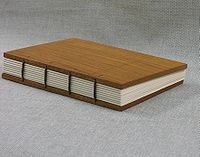
Coptic binding
Encyclopedia

Bookbinding
Bookbinding is the process of physically assembling a book from a number of folded or unfolded sheets of paper or other material. It usually involves attaching covers to the resulting text-block.-Origins of the book:...
developed by early Christians in Egypt, the Copts, and used from as early as the 2nd century AD to the 11th century. The term is also used to describe modern bindings sewn in the same style.
Coptic bindings, the first true codices
Codex
A codex is a book in the format used for modern books, with multiple quires or gatherings typically bound together and given a cover.Developed by the Romans from wooden writing tablets, its gradual replacement...
, are characterized by one or more sections
Section (bookbinding)
In bookbinding, section refers to a group of bifolios, or sheets of paper, stacked together and folded in half. The term is sometimes used interchangeably with signature, though the latter technically refers only to the signature mark at the bottom of the first page of a printed section. The...
of parchment, papyrus, or paper sewn through their folds, and (if more than one section) attached to each other with chain stitch linkings across the spine. In practice, the phrase "Coptic binding" usually refers to multi-section bindings, while single-section Coptic codices are often referred to as "Nag Hammadi
Nag Hammadi library
The Nag Hammadi library is a collection of early Christian Gnostic texts discovered near the Upper Egyptian town of Nag Hammadi in 1945. That year, twelve leather-bound papyrus codices buried in a sealed jar were found by a local peasant named Mohammed Ali Samman...
bindings," after the 13 codices found in 1945 which exemplify the form.
Nag Hammadi bindings
Nag Hammadi bindings were constructed with a textblock of papyrusPapyrus
Papyrus is a thick paper-like material produced from the pith of the papyrus plant, Cyperus papyrus, a wetland sedge that was once abundant in the Nile Delta of Egypt....
sheets, assembled into a single section and trimmed along the fore edge after folding to prevent the inner sheets from extending outward beyond the outer sheets. Because the inner sheets were narrower than the outer sheets after trimming, the width of text varied through the textblock, and it is likely that the papyrus was not written on until after it was bound; this, in turn, would have made it a necessity to calculate the number of sheets needed for a manuscript before it was written and bound. Covers of Nag Hammadi bindings were limp leather, stiffened with waste sheets of papyrus. The textblocks were sewn with tackets, with leather stays along the inside fold as reinforcement. These tackets also secured the textblock to the covers; on some of the Nag Hammadi bindings, the tackets extended to the outside of the covering leather, while on others the tackets were attached to a strip of leather which served as a spine liner, and which was in turn pasted to the covers. A flap, either triangular or rectangular, extended from the front cover of the book, and was wrapped around the fore edge of the book when closed. Attached to the flap was a long leather thong which was wrapped around the book two or three times, and which served as a clasp to keep the book securely shut.
Multi-section Coptic bindings

Approximately 120 original and complete Coptic bindings survive in the collections of museums and libraries, though the remnants of as many as 500 Coptic bindings survive.
Modern Coptic bindings
Modern Coptic bindings can be made with or without covering leather; if left uncovered, a Coptic binding is able to open 360°. If the leather is omitted, a Coptic binding is non-adhesive, and does not require any glue in its construction.Artisans and crafters often use coptic binding when creating hand made art journals or other books.

